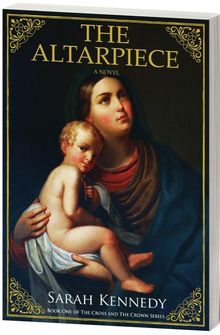|
The historical record is rarely a democratic one. Infrequently do the voices of those deemed subservient by and to the ruling elites speak from the past.
Yet, in her meticulously researched, deftly written, and effectively plotted novel, The Altarpiece—the first book of The Cross and the Crown series—Sarah Kennedy gives both voice and echo to the women at the Priory of Mount Grace in Yorkshire, England. Every woman a professed sister, each one has entered the convent for disparate and ultimately pragmatic reasons not always related to purely religious faith. The priory the women inhabit, ancestral home of their proud, stubborn, and wonderfully human prioress (as ornery and as principled as Pulitzer Prize-winner Elizabeth Strout’s Olive Kitteridge), is in imminent danger of violent appropriation by the sword-wielding henchmen of Henry VIII, self-ordained head of the Church in England. When the Mount Grace chapel’s valuable altarpiece goes missing while Henry’s troops loom about the convent grounds both day and night, political and personal forces collide, drawing the reader into a mysterious web of complex and startlingly vivid relationships between and among aristocratic and religious authorities, village men and women, and the sisters themselves. Though many of Mount Grace’s women wish to believe otherwise, the King has become unfailingly ruthless in his treatment of those who refuse to accede to his supremacy over the Church of Rome. Among the women is the novel’s protagonist, Catherine Havens, the prioress’ adopted daughter. Twenty-year-old Catherine Havens, a fascinating mix of traditional maiden and upstart physician, provides the central locus for the novel’s fast-paced plot. Catherine’s advanced learning, her ability to read, write, draw, and heal, label her both as the Blessed Mother’s own pure daughter and, conversely, as Pandora’s libelous progeny or Eve’s first cousin. When a spate of gruesome illnesses and multiple deaths contaminate the village, Catherine gains both the tentative trust and her gender’s suspicion of those with whom she would not ordinarily associate in her position as consecrated virgin. Among them is William Overton, the younger brother in a family loyal to the King. When Catherine nurses William back to health after his arduous and nearly fatal illness, her intimacy with him leads her to question her proper place and role in a dangerous, shifting world. Kennedy keeps the reader engaged and guessing with every scene. Who stole the altarpiece in the dark? Where has it been hidden? When will the King’s men invade the priory? Will their growing greed for loot and their equal lust for consecrated flesh trump their knightly courtesy? Is a murderer afoot? Have healing herbs been substituted with poison? Will Catherine deny her god for her king, for William, or for both? Kennedy explores each and every question, never giving away information too soon, but rather parceling it out in logical, fascinating bits that draw the reader closer and closer to the characters so that we soon forget they are characters at all and believe them to be living, breathing human beings. The novel’s language is often lyrical (Kennedy has written seven books of verse, as well), as seen here: “Her first receipt book, a tiny one, the size of a girdle book. It had been illuminated by Veronica with vines and flowers. She closed her fingers on the embossed cover. So easy to conceal. Like a belief.” But the language can also turn brutal: “Catherine writhed and scrabbled with her heels. She was almost under the table by now, and Adam crawled after her. She kicked him savagely in the leg and he slammed her against the floor.” Attuned to both the subtle beauties of a field flower and the blatant piercing of flesh by a dagger, Kennedy invites the reader to fully inhabit the uncertain world of her characters. In doing so, her historical novel is at once a mirror to an imagined past and a probing of our own tenuous present. The very terror Catherine and her sisters experience certainly parallels that of some readers in our own time and places. Shifting alliances, both political and personal, rock the very foundations of their beliefs and trust. Imminent deaths, whether by disease or violence, shadow every decision and act. Even the idea of a future is questioned. By turns delightful and troubling, Kennedy’s novel is riveting. The Altarpiece bodes well for the novels to follow in this series. |
The Altarpiece. By Sarah Kennedy. Knox Robinson Publishing, 2013.
|
CURRENT ISSUE
|
CONTACT
|
DEPARTMENT OF ENGLISH
|


